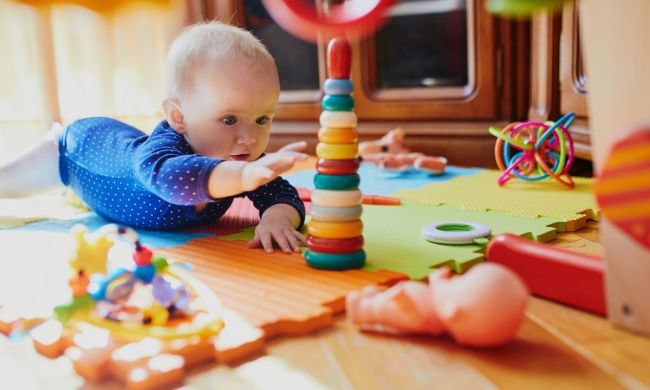Babies look at everything as a toy. Since playing is actually learning for babies, educational baby toys are a great way to both entertain and educate your baby at the same time. But what toys are appropriate for babies that are 10 – 12 months old? For babies in this age range, motor skills and coordination must be developed. You can also begin to introduce numbers, shapes, colors, and start to encourage creativity. There is a massive selection to choose from when it comes to baby toys, so if you are feeling overwhelmed or having trouble choosing the right toys, we are here to help.
VTech Stack and Sing Rings

This toy is an improvement on the classic stackable rings. The set comes with 5 rings that are different colors and textures, which allows for color recognition learning and tactile ability improvement. Motor skills and hand-eye coordination are sharpened as your baby uses their hands to stack the rings onto the tower. The new feature of this toy is a light-up monkey at the top of the pole that also plays songs. These features make the toy interactive for babies and keep them entertained while improving visual and auditory learning senses. The songs also introduce babies to numbers, shapes, and colors.
Fat Brain Toys Dimpl Baby Toys

This toy comes with five brightly colored silicone pop toys that feel exciting to babies. The different colors are visually appealing and improve your baby’s color recognition abilities. The toy itself is simple – babies experiment with how each part pops by touching them and putting them in different positions. The process of rearranging the colored poppers teaches cause and effect. The hands-on experience develops hand-eye coordination and motor skills.
VTech Sit-to-Stand Learning Walker

This walker toy comes in different colors so you can get the color scheme your little one loves. The activity panel can be removed and put back into place wherever you would like, which makes this toy versatile. The toy can be laid flat on the ground for babies that aren’t ready to walk and then adjusted into a walker by adding wheels when your baby is ready to get moving. This toy is sure to entertain your baby for many months, if not years, as it grows with your child. The toy comes with piano keys that babies can press and then listen to music, which develops motor skills and hand-eye coordination. There is also a shape sorter toy on the walker that allows your baby to learn about shapes and develops problem-solving skills.
Playskool Play Favorites Busy Poppin’ Pals

This pop-up toy set is interactive and engaging and will entertain your baby for hours. Your baby will enjoy turning and twisting the different levers and watching the toy bugs pop up. This hands-on playing develops motor skills and hand-eye coordination and illustrates cause and effect. The toy also teaches about shapes and colors through recognition and introduces animal learning.
Fisher-Price Laugh & Learn Sis’ Remote

Babies love remote controls. This Fisher-Price toy looks like a remote control, features over 35 songs, and a screen that lights up. The interactive features help to improve your baby’s auditory and visual senses while pressing the buttons introduces them to letters, numbers, and colors. Pressing the buttons is excellent for motor skills and hand-eye coordination, and the responses from the buttons teach about cause and effect.
VTech Busy Learners Activity Cube

This Activity Cube by Vtech is a busy baby’s dream come true. It has five sides filled with activities and 14 interactive features. The toy has buttons that light up and teach cause and effect. The buttons also introduce shapes and animals to your baby. There are 25 different songs and different animal noises that play through this toy and stimulate auditory learning. The features of this toy are mostly hands-on, including sliding and spinning blocks, which improve motor skills and hand-eye coordination.
Fisher-Price Baby’s First Blocks

This block set is a classic fit-the-block-in-the-hole game for your baby. The ten blocks are bright colors and different shapes that help to teach your child about shapes and colors. The blocks can be used to build, which improves motor skills and hand-eye coordination, or can be placed into the holes on the block carrying case to teach problem-solving skills and color and shape recognition.
Fat Brain Toys MiniSpinny

This interactive toy from Fat Brain has pieces that are bright in color and spin onto a spindle which entertains babies for hours. This toy teaches color recognition, hand-eye coordination, counting, and motor skills. The toy is visually appealing, and parents like how easy it is to keep their baby engaged with the toy.



